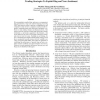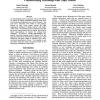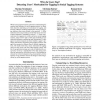ICWSM
2010
14 years 5 months ago
2010
Microblogging has recently generated a lot of research interest. Yet very little is known about how corporate employees use microblogging tools. This study examined microblogging ...
ICWSM
2010
14 years 5 months ago
2010
We use quantitative media (blogs, and news as a comparison) data generated by a large-scale natural language processing (NLP) text analysis system to perform a comprehensive and c...
ICWSM
2010
14 years 5 months ago
2010
To better understand and characterize the emerging social medium of microblogging we conducted a comparison between Twitter and a weblog network for their respective information d...
ICWSM
2010
14 years 5 months ago
2010
In this paper, following the IT acceptance theory framework, we analyze factors that affect users' acceptance of micro-blogging in a large corporate environment. We categoriz...
ICWSM
2010
14 years 5 months ago
2010
As microblogging grows in popularity, services like Twitter are coming to support information gathering needs above and beyond their traditional roles as social networks. But most...
ICWSM
2010
14 years 5 months ago
2010
We connect measures of public opinion measured from polls with sentiment measured from text. We analyze several surveys on consumer confidence and political opinion over the 2008 ...
ICWSM
2010
14 years 5 months ago
2010
While recent progress has been achieved in understanding the structure and dynamics of social tagging systems, we know little about the underlying user motivations for tagging, an...
ICWSM
2010
14 years 5 months ago
2010
ICWSM
2010
14 years 5 months ago
2010
In this study, we examine human social interactions within virtual worlds and address the question of how group interactions are affected by the surrounding game environment. To i...
ICWSM
2010
14 years 5 months ago
2010
The spread of influence among individuals in a social network can be naturally modeled in a probabilistic framework, but it is challenging to reason about differences between vari...



